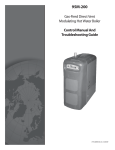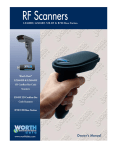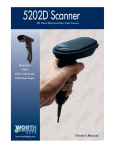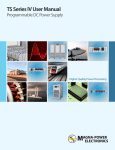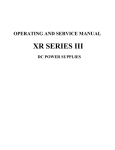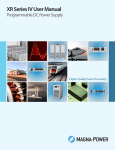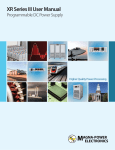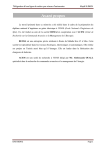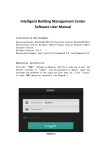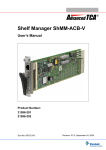Download Dunkirk Q95M-200 Troubleshooting guide
Transcript
95M-200 GAS-FIRED DIRECT VENT MODULATING HOT WATER BOILER Control Manual And Troubleshooting Guide P/N# 240006104, Rev. E [03/2013] 1- TABLE OF CONTENTS 1- Table Of Contents ...................................................................................................... 2 2 - Important Safety Information .................................................................................... 3 3 - Operating Information ............................................................................................... 4 4 - Modulating Control Features....................................................................................... 6 5 - Boiler Startup .......................................................................................................... 7 6 - Checkout Procedures And Adjustments ........................................................................ 9 7 - Detailed Sequence Of Operation ............................................................................... 12 8 - Service Hints ......................................................................................................... 13 9 - Troubleshooting...................................................................................................... 14 10 - User Interface Quick Reference ............................................................................... 21 11 - Installation And Checkout Certificate ....................................................................... 28 2 2 - IMPORTANT SAFETY INFORMATION General Installation shall conform to requirements of authority having jurisdiction or in absence of such requirements: Boiler installation shall be completed by qualified agency. • United States ! WARNING • National Fuel Gas Code, ANSI Z223.1/NFPA 54. Fire, explosion, asphyxiation and electrical shock hazard. Improper installation could result in death or serious injury. Read this manual and understand all requirements before beginning installation. • National Electrical Code, NFPA 70. • Canada • Natural Gas and Propane Installation Code, CAN/CSA B149.1. and .2 Keep this manual near boiler Retain for future reference • Canadian Electrical Code, Part I, Safety Standard for Electrical Installations, CSA C22.1 Where required by authority having jurisdiction, installation shall conform to Standard for Controls and Safety Devices for Automatically Fired Boilers, ANSI/ASME CSD-1. Become familiar with symbols identifying potential hazards. Additional manual reset low water cutoff and/or manual This is the safety alert symbol. Symbol alerts you to reset high limit may be required. potential personal injury hazards. Obey all safety messages following this symbol to avoid possible injury or death. ! WARNING ! Revision, modification, substitution or elimination of factory equipped, supplied or specified components could result in death or serious injury. DANGER Indicates a hazardous situation which, if not avoided, WILL result in death or serious injury Use of this manual shall be by a qualified heating installer or service technician only. Before programming control read and understand all instructions including : ! WARNING Indicates a hazardous situation which, if not avoided, could result in death or serious injury. • Installation, Operation and Maintenance Manual, • Parameter Guide • Control Manual and Troubleshooting Guide ! CAUTION Perform all steps in order specified. Indicates a hazardous situation which, if not avoided, could result in minor or moderate injury. NOTICE Used to address practices not related to personal injury. 3 3 - OPERATING INFORMATION 3. DHW heating: Target temperature is determined by Boiler is controlled by microprocessor electronic control that senses: adding Parameter 1 to Parameter 33 (default 150°F and 30°F). Do not change Parameter 1 from factory default setting of 150°F unless application is specially engineered for other temperature. DHW heating default setting is 180°F. • Outlet water temperature, • Return water temperature, • Outdoor temperature (when factory supplied, field installed outdoor sensor is installed). Information sensed plus input from external limit and operating controls is used to regulate boiler on/off operation and will modulate boiler firing rate to more closely match output to demand. 4. High limit operation: If outlet water temperature exceeds target temperature (or 180°F, whichever is lower), high limit action occurs. Control module shuts burner off showing “b 9” followed by “26” on display. 5. DHW operation (if used): Boiler is factory set to Electrical Specifications change target outlet water temperature to 180°F on call for heat from DHW aquastat. Boilers require 120 VAC/60 HZ power supply and are not polarity sensitive. 6. Additional Thermal Overrun Protection: High limit operation shuts down burner when outlet water temperature exceeds target temperature. Adverse conditions could cause water temperature to rise too quickly and overshoot this temperature. Control’s advanced technology provides protection in event of thermal overrun. Using its electronics, control provides two additional levels of overrun protection: CONTROL SPECIFICATIONS Supply voltage 120 Vac/60 hz Electrical demand 10 VA Pre-purge timing 10 Seconds Post-purge timing 15 Seconds Min. off time, space heating 10.2 Seconds Pump on after space htg. 0 Minutes Min. off time, DHW 10.2 Seconds Pump on after DHW 30.6 Seconds Line voltage fuse, F1 5 Amp fast-blow Low voltage fuse, F3 4 Amp slow-blow • Level 1: Indication occurs if supply water temperature reached 183°F. Control displays soft lockout code (“b 9” followed by “18” if on supply or “19” if on return). Control will not operate burner again until water temperature dropped 9°F below target temperature. • Level 2: Lockout occurs if supply water temperature reaches 200°F or if return water reaches 193°F. Control will enter hard lockout and display error code (“E” followed by “18” if on supply or “19” if on return). Boiler Circulator NOTICE • Circulator has sufficient head to handle boiler pressure drop plus reasonable pressure drop in connecting piping. See the Installation, Operation and Maintenance Manual for piping information. Hard lockout requires manually pressing display panel reset button to restart operation. Service technician must troubleshoot cause of problem and correct it before placing boiler back in operation. • Boiler control’s internal relay contact is suitable for handling only the boiler circulator provided. • Do not wire additional pumps in parallel with boiler circulator. Low Water/Low Flow Protection 1. Boiler is factory equipped with manual reset probe type • To operate system circulator when boiler circulator is running, see “Electrical Wiring” section in Installation, Operation and Maintenance Manual for wiring required. low water cutoff. 2. Boiler control uses temperatures sensed at both supply and return areas of heat exchanger. If flow rate is too low (temperature difference too high) or either temperature is too high, control shuts boiler down. Ensures boiler shutdown in event of low water or low flow conditions. Boiler Temperature Regulation Operating temperature (target): Control senses outlet water temperature and regulates boiler firing rate to achieve target temperature set by installer using Parameter 4. Temperature can be set between 120°F and 194°F. Freeze Protection 1. Space heating: Target temperature is fixed (equal Do not install boiler in room likely to freeze. to Parameter 4) when outdoor reset is not installed or calculated as described under “Outdoor Reset Operation” page 5, when outdoor sensor is connected. Following boiler control feature provides some protection for boiler only, not for the system. 2. Exception: See explanation of “Supply Temperature Boost” page 5. 4 3 - OPERATING INFORMATION DHW heating. Control module provides freeze-up protection when boiler water temperature drops below 45° F: DHW Operation (option) • Below 45° F, boiler circulator operates constantly. • Below 37° F, boiler operates at low fire. • Boiler and circulator turn off if boiler water temperature rises above 50° F. This boiler control feature does not eliminate possibility of freezing. Installation must use recognized design, installation and maintenance practice to prevent freeze potential for boiler and system. Control allows connection of DHW aquastat to low voltage terminal strip terminals DHW T1 and DHW T2. When DHW aquastat calls for heat, module shuts down boiler circulator activated DHW circulator and immediately sets target outlet water temperature to 180°F. This provides automatic priority heat allocation to indirect water heater for maximum response and recovery. DHW circulator continues for 30.6 seconds after heating cycle to deliver heat. Supply Temperature Boost • Outdoor reset operation (factory supplied, field installed outdoor sensor connected), boiler control automatically increases target outlet water temperature if call for heat exceeds 10 minutes. • At each 10 minutes of continuous call for heat, control module increases target temperature by 18°F. Module continues increasing target temperature until it reaches value set in Parameter 4. • When call for heat ends while target temperature is “boosted,” target temperature drops about 2°F for each minute thermostat is open. Reset Curve Calculations Reset Curve Calculations Outdoor Reset Target Temperature 210 Parameter 4 = 190°F Target Outlet Temperature, °F 190 Purpose of “Boosting”: If target temperature is too low, control “boosts” target temperature until supply water meets system needs. Outdoor Reset Operation Target temperature with outdoor reset: All boilers ship with outdoor temperature sensor. When sensor is installed (low voltage terminal strip terminals A1 and A2), boiler control regulates target outlet water temperature based on outside temperature. Parameter 4 = 170°F 170 160 Parameter 4 = 150°F 150 130 120 110 90 70 50 70 60 50 Set temperature curve by setting Parameter 4 to: 40 30 20 10 0 -10 -20 Outside Temperature, °F Default Reset Curve • ODT (outdoor design temperature for the area). • ODT of 0°F or lower, set Parameter 4 to desired supply temperature at ODT. • ODT above 0°F, set Parameter 4 to desired system temperature when outdoor temperature is 0°F. Reset curve: See reset curve graph, shows how boiler control calculates target temperature. Default Reset Curve Outdoor Reset Target Temperature 210 Target Outlet Temperature, °F 190 • Outdoor temperature at or below 0°F, target temperature equals Parameter 4 and never higher. • Outdoor temperature above 0°F, target temperature is reduced on a curve that would result in 60°F supply temperature at 70°F outdoor temperature. Summer/winter switch option: Install summer/winter switch, if desired, to disable boiler (space heating) circulator during non-heating months. Connect switch across outdoor sensor terminals. When switch closes, boiler circulator is disabled and boiler operates only on call for Parameter 4 = 180°F 180 170 160 150 130 120 110 90 70 Parameter 6 = 0°F Parameter 7 = 60°F 50 70 60 50 40 30 20 10 Outside Temperature, °F 5 0 -10 -20 4 - MODULATING CONTROL FEATURES Boiler Control Design IMPORTANT: • Integrated modulating boiler control is designed for central heating (CH) hot water boilers with modulating fan and gas-air control. • Modulation is based upon data relayed to control by temperature sensors. • Burner uses direct spark igniter (DSI). • Modulating boiler control is intended for use in combination with user interface display unit for both information and operation. • Control is designed for installation with conventional on/ off dry contact room thermostat. • Control is able to provide hot water and outdoor reset functions. This boiler is equipped with a feature that saves energy by reducing the boiler water temperature as the heating load decreases. This feature is equipped with an override which is provided primarily to permit the use of an external energy management system that serves the same function. This Override Must Not Be Used Unless At Least One Of The Following Conditions Is True: • An external energy management system is installed that reduces the boiler water temperature as the heating load decreases. • This boiler is not used for any space heating. • This boiler is part of a modular or multiple boiler system having a total input of 300,000 BTU/hr or greater. Main Controller Functions Central Heat (CH): Control uses sensors on supply water, return water and outside air to determine heat load of heating system. Results in boiler supplying just enough heat to satisfy demand which results in fewer overshoots and less short cycling than conventional boiler. Domestic Hot Water (DHW): When used in conjunction with indirect hot water heater boiler has capability to provide domestic hot water. An on/off dry contact aquastat is used to activate call for domestic hot water. Outdoor Reset: Control senses outside air temperature using factory supplied, field installed sensor. Controller detects presence of sensor and reacts according to parameters programmed into controller. User Interface Display User interface display allows installer and home owner to scroll through control settings and customize boiler to heat delivery system used in installation location. See “User Interface Quick Reference” Section 10, page 21 for more information on using and programming boiler control. 6 5 - BOILER STARTUP 4. Control module turns on DHW circulator when indirect NOTICE water heater operating control closes. Control module shuts off boiler circulator (stops space heating) during calls for DHW heating. Instructions in this manual are based on factory default parameter settings. Startup Verify Operation – Space Heating 1. Start boiler after completing all instructions in Information below presented in brackets “[ ]” represents actual boiler control panel display with first digit indicating boiler status and last three digits showing measured boiler water temperature. (Ex.- [A180] indicates status of “A” and boiler water temperature of 180°F.) Installation, Operation and Maintenance Manual. 2. Start boiler by turning thermostat up to call for heat. 3. Once boiler has started and is operating, continue startup procedure by performing all following steps to set and verify operation of controls. 1. Turn down DHW aquastat on DHW tank (if used). If necessary, turn off power and remove one of DHW aquastat wires to ensure boiler will not receive DHW heat call. Set Space Heating Operation 1. Verify Space Heating Mode 2. Turn off power to boiler at service switch. A. Press “Mode” button until display shows [PARA]. This is parameter mode. B. Press “Step” button until first digit of display shows “3.” C. Last digit must show “1.” If any other number displays, press “+” button until “1” shows in righthand digit, then press “Store” button to save this setting. 3. Wait few seconds, then turn on power to boiler. • [180] Self-check on power-up for a few seconds. • [0180] No call for heat. 4. Raise room thermostat to call for heat. • [5180] Blower/boiler circulator on. Blower and boiler circulator energize and control checks for air flow. 2. Set space heating target temperature • [1180] Pre-purge. Blower speed will increase to ignition speed. Blower will run in pre-purge for 10 seconds. A. Press “Step” button until first digit of display shows “4.” Last three digits show outlet water temperature setting. B. Press “+” or “-” buttons to change setting to desired outlet water temperature. Factory default setting is 180°F. • [2180] Ignition. After pre-purge, control module opens gas valve and starts ignition spark. • If burner flame proves within 4.5 seconds, burner continues to fire. Burner will fire at startup rate for about 10 seconds to allow flame to stabilize. • Outdoor sensor installed: Setting is target temperature for outdoor temperature at or below factory setting (32°F). At higher outside temperatures, control module calculates target temperature. • If burner flame does not prove within 4.5 seconds, control module attempts ignition sequence again. Flame must prove within 6 attempts or control will lockout (display will show [E 02]). • When summer/winter switch is used, closing switch will disable boiler (space heating) circulator during summer operation. • Verify flame failure operation by closing boiler manual gas cock to prevent gas flow. Open manual gas valve after testing. • Outdoor sensor not installed: Setting is target temperature at all times. • [3180] Burner on, space heating. Once flame is proven and stable, burner turns down to low fire for approximately 2 minutes. C. Press “Store” button to save setting. • After this low fire period, burner is allowed to modulate. Firing rate depends on actual outlet water temperature versus target temperature. Check DHW Operation Setup If control is already in parameter mode , skip step 1 (below) and proceed to step 2. 5. Allow boiler to bring water temperature to target temperature. 1. Press “Mode” button until display shows [PARA] • [6180] Target temperature reached. Burner shuts down. Blower runs in post-purge (see below), then turns off. Boiler circulator continues to run as long as there is call for heat. (parameter mode). 2. Press “Step” button until first digit of display shows “2.” 3. Last digit must show “1.” If another number displays, 6. Lower room thermostat to stop call for heat. press “+” button until “1” shows in right-hand digit, press “Store” button to save this setting. 7 5 - BOILER STARTUP 6. Lower DHW aquastat to stop call for heat. • [1180] Post-purge. When room thermostat is satisfied (call for heat ended), burner turns off. Blower continues for 15-second post-purge, then turns off. If another call for heat occurs, boiler remains off for ten seconds before starting again, and display shows [6180]. • [1150] Post-purge. When room thermostat is satisfied (call for heat ended), burner turns off. Blower continues for 15 second post-purge, then turns off. If another DHW heat call occurs, boiler begins heating cycle after 10 second delay. If CH call for heat occurs after DHW demand, heating cycle begins after 30 second delay. • [0180] No call for heat. Boiler is in standby mode (waiting for heat call). • [8150] DHW circulator run-on. DHW circulator continues to run for 30 seconds. 7. Repeat steps 1-6 several times to verify operation. 8. Return room thermostat to normal setting. • [0150] No call for heat. Boiler is now in standby mode (waiting for heat call). Verify Operation – DHW 7. Repeat steps 1-6 several times to verify operation. 1. If necessary, reconnect DHW aquastat wiring to boiler. 8. Return DHW aquastat to normal setting. 2. Turn off power to boiler at service switch. 3. Wait few seconds, turn on power to boiler. Operating Information [A150] Self-check on power-up for a few seconds. 1. To check operating conditions (Ex - actual or target temperature), see “User Interface Quick Reference” Section 10 page 21, for explanation of boiler control’s “Information” mode. [0150] No call for heat. 4. Raise DHW aquastat above tank temperature to call for heat. 2. During normal operation (no shutdown or lockout), • [5150] Blower/DHW circulator on. Blower and DHW circulator energize and control checks for air flow. right 3 display digits show actual boiler outlet water temperature. • [1150] Pre-purge. Blower speed increases to ignition speed. Blower runs in pre-purge for 10 seconds. Perform Check-out Procedures • [2150] Ignition. After pre-purge, control module opens gas valve and starts ignition spark. Complete “Checkout Procedures and Adjustments” as indicated in Section 6 page 9. • If burner flame proves within 4.5 seconds, burner continues to fire. Burner fires at startup rate for about 10 seconds to allow flame to stabilize. Replace boiler front jacket panel after performing any service to boiler. • If burner flame does not prove within 4.5 seconds, control module attempts ignition sequence again. Flame must prove within 5 attempts or control will lockout (display will show [E 02]). • Verify flame failure operation by closing boiler manual gas valve to prevent gas flow. Open gas valve after testing. • [4150] Burner on, DHW. Once flame is proven and stable, burner is allowed to modulate. Firing rate depends on actual outlet water temperature versus target temperature. 5. Allow boiler to bring water temperature to target temperature. • [6150] Target temperature reached. Burner shuts down. Blower runs in post-purge, then turns off. DHW circulator continues to run as long as there is call for DHW heating. 8 6 - CHECKOUT PROCEDURES AND ADJUSTMENTS Verify Sequence Of Operation Test Other Field Installed Safety Controls (if used) Detailed sequence of operation containing faults can be found in Sections 7, “Detailed Sequence of Operation.” Refer to this section and Section 8, “Service Hints,” for more information. If boiler is equipped with any additional safety controls, test for operation as outlined by control manufacturer. Burner should be operating and go off when controls are tested. When safety controls are restored, burner should reignite. Inspect Venting And Air Intake Set Field Installed Thermostat Operate boiler and verify all vent/air intake connections are gas tight and watertight. Repair any leaks immediately. Heat Anticipator (if used) Inspect Condensate Drain And System Piping • For single thermostat connected to T-T screw terminals on low voltage terminal strip on control board of boiler, set heat anticipator at 0.1 amps. Verify condensate flows freely and all connections are watertight. Repair any leaks immediately. • For other wiring configurations, refer to instructions provided by thermostat manufacturer regarding heat anticipator adjustment. Test Ignition System Safety Shutoff Device 1. Remove front panel from appliance. • Cycle boiler with thermostat. Raise thermostat to highest setting. Verify boiler goes through normal start up cycle. Lower thermostat to lowest setting. Verify boiler goes off. 2. Turn off manual gas ball valve. 3. Set thermostat for a call for heat. 4. Boiler begins normal sequence of operation. 5. After approximately 30 seconds of pre-purge appliance will attempt to light. Boiler Adjustment 6. After 4 seconds gas valve closes and control retries 5 1. Check incoming gas pressure to appliance using times, before entering lockout mode. pressure gauge with resolution of 0.1” w.c. or better and range from 0” to at least 14” w.c. 7. To reset the control, follow the instructions in Section IV of this manual, “Putting The Boiler In Operation.” 2. Close gas shutoff inside boiler jacket. 8. Return thermostat to previous setting. 3. Locate inlet pressure tap on gas valve. See Figure 1. Test And Adjust High Limit Control 4. Open inlet pressure tap screw ½ turn. • With burner operating, adjust setting on high limit control below actual boiler water temperature. 5. Connect positive side of gauge to inlet pressure tap. • Burner will go off while circulator continues to operate. 7. Gas pressure at high fire should read between 4” and 6. Open gas shutoff. 10” w.c. for natural gas and between 10” and 14” w.c. for LP gas. • Raise limit setting above boiler water temperature and burner will reignite after pre purge and igniter warm-up period. • Set high limit control to 10°F above parameter 4 setting as described in “Parameter Guide”. Figure 1 - Gas Valve • Maximum high limit setting is 200°F. Minimum high limit setting is 100°F. Test Low Water Cut Off 1. Disconnect wire from LWCO sensor probe. 2. Set thermostat for call for heat. 3. Boiler will not begin normal sequence of operation. 4. Attach wire to sensor probe. 5. Return thermostat to previous setting. 9 6 - CHECKOUT PROCEDURES AND ADJUSTMENTS 8. Drill ½” hole in plastic CPVC vent pipe or exhaust 8. Boiler must be in high fire mode for this operation. See tee, just large enough to allow access for combustion analyzer sample probe. “User Interface Quick Reference” section 10, for more information on placing boiler in high fire mode. 9. Turn thermostat to closed position so appliance is Calculate BTUH Input Rate as follows: activated. Btuh input rate = 10. Set appliance to high fire mode as described in “User 3600 x heating value from Step 4 time in seconds Interface Quick Reference” section 10 page 21 and allow it to run for approximately 5 minutes. 9. Measured input rate varies with vent length, gas calorific content, altitude and ambient temperature. Set boiler with combustion specifications in “Boiler Adjustment” section 6 page 9. 11. Insert sample probe of your combustion analyzer into drilled hole from Step 8. Insert about halfway into exhaust gas stream. Take flue gas reading and observe % CO2 and CO values. Adjust throttle screw until correct readings are reached. 12. Turning throttle screw clockwise decreases rate and Determine Lp Gas Input Rate 13. Allow appliance to stabilize for one minute after Determine LP gas input rate by measuring C02 produced during combustion. Set this value according to guidelines table on page 11. CO2 value. Turning throttle screw counter clockwise increases rate and CO2 value. adjusting throttle screw before you take reading with combustion analyzer. Measure Flame Sense NOTICE CO levels should not exceed 80 ppm. 14. Set appliance to low fire mode as described in “User Interface Quick Reference” section. Check CO2 level as stated in Step 5. Low fire and high fire values should be approximately same. 15. After adjustments are made stop appliance. Disconnect pressure gauge, tighten inlet pressure tap on gas valve, remove CO2 meter from CPVC pipe, and seal hole with ¼” NPT black iron plug. Use thread sealing compound or teflon tape to ensure proper seal. 16. Return thermostat switch to its original position. Flame sense can be indicator of issues with air intake venting, exhaust venting, burner and ignitor condition and supply gas piping pressure. Use multi meter capable of reading 0-20 VDC. Attach one lead to “F” terminal on low voltage terminal block on boiler control. Attach other lead to any ground surface on boiler. See Figure 2. Flame sense voltage shall be in accordance with values listed in Flame Signal Guidelines chart page 11. Measure Natural Gas Input Rate 1. Correct input rate is essential for proper and efficient operation of burner and boiler. Figure 2 Multimeter 2. Determine elevation at installation site. 3. See “Installation, Operation and Maintenance Manual” to determine correct approximate input rate for local elevation. 4. Obtain yearly average heating value of local gas utility. At sea level elevation, it should be about 1000 BTU per standard cubic foot. 5. Operate boiler for 5 minutes. 6. Turn off all other gas appliances, extinguishing standing pilots where applicable. 7. At gas meter, measure time in seconds required to use one cubic foot of gas. 10 6 - CHECKOUT PROCEDURES AND ADJUSTMENTS Pressure Guidelines Fan Speed Minimum RPM Maximum RPM Fuel Natural Gas LP Natural Gas LP Gas Line Inlet N/A N/A At least 4” WC At least 10” WC Pressure Differential Pres0.3” WC 2.0” WC sure Note: Differential pressure values listed for comparison only. These values will change with vent length and altitude of installation. Combustion Guidelines Outside Natural Gas LP Gas Temperature *%CO2 *%O2 CO *%CO2 *%O2 CO 70°F and up 21°C and up 30°F to 70°F -1°C to 21°C 30°F and below -1°C and below 9.6% to 10% 3.9% to 3.2% Less than 80 PPM 11.1% to 11.5% 4.1% to 3.4% Less than 80 PPM 9.3% to 9.6% 4.4% to 3.9% Less than 80 PPM 10.8% to 11.1% 4.5% to 4.1% Less than 80 PPM 9.0% to 9.3% 5.0% to 4.4% Less than 80 PPM 10.5% to 10.8% 4.9% to 4.5% Less than 80 PPM * Percent CO2 values may exceed those listed and percent O2 values may be less than those listed in order to achieve nominal input rate of boiler. Flame Signal Guidelines Fan Speed Flame Signal Minimum RPM Greater than 3.0 VDC Maximum RPM Greater than 3.0 VDC 11 7 - DETAILED SEQUENCE OF OPERATION POWER ON. UNIT IN STANDBY THERMOSTAT CALLS FOR HEAT INTERNAL MICRO CONTROLLER TEST CIRCULATOR ENERGIZES CONTROL CHECKS N O AIR PRESSURE SWITCH CONTACTS CLOSED OPEN FALSE POSITIVE PROOF OF AIRFLOW COMBUSTION AIR BLOWER ENERGIZES CONTROL ENTERS LOCKOUT ERROR CODE DISPLAYED CONTROL WAITS FOR AIR PROVING SWITCHES TO CLOSE INDICATING SUFFICIENT FAN SUCTION PRESENT CONTROL NEEDS TO BE RESET FROM LOCKOUT CLOSED OPEN CONTROL ENTERS LOCKOUT ERROR CODE DISPLAYED CONTROL ENTERS PRE-PURGE COMBUSTION AIR BLOWER RUNS FOR 20 SECOND PRE-PURGE CONTROL NEEDS TO BE RESET FROM LOCKOUT SPARK IGNITER ACTIVATES GAS VALVE OPENS UNIT LIGHTS AND FLAME RECTIFICATION YES UNIT OPERATES NORMALLY ATTEMPT TO LIGHT NO UNIT TRIES FOR IGNITION 5 TIMES DOES NOT LIGHT AFTER 6 TRIES END CALL FOR HEAT CONTROL ENTERS 30 SECOND POST PURGE UNIT ENTERS STANDBY, WAITING FOR CALL FOR HEAT 12 CONTROL ENTERS LOCKOUT ERROR CODE DISPLAYED CONTROL NEEDS TO BE RESET FROM LOCKOUT 8 - SERVICE HINTS Troubleshooting Tools ! WARNING Tools needed for troubleshooting your boiler: Fire, Explosion, Shock Hazard. Revision, modification, substitution or elimination of factory equipped, supplied or specified components could result in death or serious injury. • Voltmeter that can check 120 VAC, 24 VAC, and 12 VDC • Continuity Tester • Contact Thermometer Important Service Information • If any component does not function properly, make sure it is correctly installed and wired before replacing it. • Inclined Manometer or Pressure Gauge with 0-6.0” range (0.01” scale) for measuring suction pressures at pressure switch • Static electricity discharge can damage the integrated modulating boiler control (IMBC). Touch metal surface to discharge static electricity before touching control. • U-Tube Manometer or Differential Pressure Gauge with 0-14” range (0.1” scale) for measuring inlet and manifold gas pressures • Boiler control cannot be repaired. If it malfunctions it must be replaced. Initial Service Checks Prior to troubleshooting: • Only trained, experienced service technicians should service boiler control systems. 1. Verify circuit breaker is ON or fuse is okay at electrical panel. • After troubleshooting, follow “Detailed Sequence of Operation” Section 7 page 12, for normal light off procedure. 2. Verify service switch is ON. 3. Verify 120 VAC (minimum 102 VAC to maximum 132 • All controls are factory tested,a defective control is generally least likely cause. If you suspect you have a defective boiler control, read “Troubleshooting” Section 9 before you replace it. • It is unlikely that two consecutive controls are defective. Chances are that either there is nothing wrong with the control or it is damaged by some other problem (for example, an electrical short burning out a transformer). VAC) to boiler. 4. Verify thermostat is calling for heat and contacts (including appropriate zone controls) are closed. Check for 24 VAC between thermostat wire nuts and ground. 5. Verify all external limit controls are either installed (and closed) or temporarily jumpered for testing. 6. Verify gas is ON at gas meter, at all appropriate manual shutoff valves, and at gas control valve. Gas pressures should be maximum of 10” w.c. (natural gas) or 14” w.c. (for LP gas) with no flow (lockup) or with boiler on and minimum of 5” w.c. with gas flowing (verify during boiler startup with boiler at high fire). 7. Verify wire connectors at boiler control and at originating control are securely plugged in or connected. 8. Verify all hoses are securely connected and are not plugged in or damaged. 13 9 - TROUBLESHOOTING ! DANGER Checking the Differential Air Pressure Electric shock hazard! Following procedures may expose you to dangerous line voltage. Use caution to avoid touching live electrical contacts. All service must be performed by a trained, experienced service technician. Failure to follow these instructions WILL result in death or serious injury ! WARNING Fire, Explosion. Shut off gas at a location external to appliance should overheating occur or gas supply fail to shut off. Do not turn off or disconnect electrical supply to pump. Do not use the boiler if any part of the gas control system has been underwater. Only a qualified service technician should inspect the boiler and replace any part of control system and any gas control which has been underwater. Use only your hand to turn gas control knob. Never use tools. If knob will not turn by hand, don’t try to repair it. Boiler Status Diff. Pressure Not Running 0” Failure to follow these instructions could result in death or serious injury. Running with Blockage Greater Than or Equal To Setpoints ! CAUTION Running w/out Blockage (approx.) WHAT TO DO IF YOU SMELL GAS Switch Contacts 3.5” Closed 0.14” Open 3.5” Open 0.14” Closed Min. Fire: 0.3” 3.5” Closed Max. Fire: 2” 0.14” Closed If manometer readings do not correspond with chart above, check for possible causes: • Do not try to light any appliance. • Do not touch any electrical switch; do not use any phone in your building. • Blockage or moisture in suction lines to switch. • Immediately call your gas supplier from a neighbor’s phone. Follow gas supplier’s instructions. • Blockage in air intake or vent pipes. • Undersized air intake or vent pipes. • Loose blower wheel on motor shaft. • If you cannot reach your gas supplier, call the fire department. • Incorrect pressure switch or pressure switch setpoint When pressure reading is correct and pressure switch is operating properly, remove testing lines and reinstall vinyl caps to Tee and 3-way connector. Differential Air Pressure Differential air pressure switch is a safety device which prevents boiler from firing if there is an air intake, boiler heat exchanger or vent blockage. To check differential air pressure: 1. Turn off service switch or lower thermostat setting. 2. Remove vinyl caps from tee. 3. Install testing lines as shown to inclined manometer or differential pressure gauge with ability to read 0.01” increments to at least 6.0” w.c. 4. Turn on service switch and set thermostat to call for heat. 14 9 - TROUBLESHOOTING ! DANGER Electric shock hazard! Disconnect power before servicing. All service must be performed by a trained, experienced service technician. Never jumper (bypass) any device except for momentary testing as outlined on the following pages of this manual. Failure to follow these instructions WILL result in death or serious injury Control Module Fuses Check control module fuses before replacing control module or any major components (blower, etc.) If one of these fuses is blown, it can prevent control module or other components from operating. 1. Turn OFF power to boiler at external line switch. 2. Remove jacket front panel. F1 and F3 Fuses 3. Remove control module cover. 4. Inspect fuses F1 and F3 (shown below). 5. Boiler is shipped with four spare fuses attached to control module cover. 6. If necessary, replace open fuse (F1 is 115V, 5-amp fast-blow; F3 is 24V, 4-amp slow-blow). 7. Install control module cover and jacket top front cover after fuse inspection. Table 1 - Sensor Resistance Values at Various Temperatures Temp °F 8. Restore power to boiler at external line switch and verify boiler operation after completing boiler service. Checking Temperature Sensors 1. Boiler temperature sensors (outdoor, return water, and supply water) are all resistance-type devices. 2. Table 1 shows correct resistance value for sensor at various temperatures. 3. Use resistance values at 32°F, 60°F, 70°F and 212°F to measure sensor resistance at known temperatures (ice point, room temperature and sea level boiling point). For ice point and boiling point, insert sensor in water at that temperature. Use ohm meter to read resistance value. 4. To verify control module is correctly sensing temperature, use a resistance decade box. Connect decade box temporarily in place of sensor. Use control module “Information” mode to read temperature. 15 Sensor Ohms Min Max Temp °F 32 34,265 37,871 40 27,834 50 60 Sensor Ohms Min Max 130 3,698 4,088 30,764 140 3,043 3,364 21,630 23,907 150 2,517 2,782 16,944 18,727 160 2,091 2,311 70 13,372 14,780 170 1,744 1,928 80 10,629 11,747 180 1,461 1,615 90 8,504 9,399 190 1,229 1,359 100 6,847 7,568 200 1,038 1,147 110 5,545 6,129 210 880 972 120 4,517 4,992 212 851 941 9 - TROUBLESHOOTING Boiler Not Firing And: Check For: Step Corrective Actions: 1 NO - Check external line switch and fuse or breaker. 2 Determine if red light on line voltage monitor is flashing indication fault. If there is fault verify input voltage dial is properly set in accordance with steps in installation manual. If fault does not clear after ten minutes replace line monitor. 120 vac on both sides of fuse F1? (Turn OFF external power to boiler before removing cover. 1 NO - Turn off power to boiler and replace fuse if necessary. Inspect boiler interior wiring to determine cause of fuse opening. Wiring correct, in good condition, and securely attached? 1 Correct if needed. Replace any damaged wiring or components. Replace control module if problem persists. Room thermostat and DHW aquastat satisfied? 1 YES - Boiler off, no call for heat. Turn up thermostat or aquastat. Boiler should start. 1 Check voltage on both sides of low voltage fuse F3. (Turn OFF external power before removing cover.) If necessary, replace fuse. Determine reason for fuse failure if possible. 2 Check/set boiler parameters 2 and 3. Make sure space heat or DHW is turned on. Turn on if necessary. 3 Turn off power to boiler. Temporarily jumper low voltage terminal strip terminals T1 and T2 or DHW T1 and DHW T2. Retry. If boiler operates, check CH and DHW thermostat and wiring. Replace if necessary. Remove temporary jumper(s). 4 Turn off power to boiler. Check wiring against wiring diagram; verify all wiring in good condition and secure. 5 Replace wire harnesses and retry. 6 Replace control module. Display first digit shows number from 1 to 8; last digits show 2 or 3-digit number (boiler outlet water temp.) 1 Boiler in normal operating mode. Display flashes “9,” then “b.” Last two digits show code number. 1 See User Interface Quick Reference and Soft Lockout Troubleshooting for more information on soft lockout code. 120 vac at terminals L1 and L2 of line voltage strip? Control display blank Display first digit shows 0; last digits show 2 or 3-digit number (boiler outlet water temp.) Thermostat or aquastat calling for heat but boiler not firing. 16 9 - TROUBLESHOOTING SOFT LOCKOUT (Display flashes “9” and then “b” in first position; last two digits on steady (code)) Code 08 18 19 Reason For Soft Lockout 0.14” Pressure switch contacts open Corrective Actions (pressing RESET should restart boiler immediately): 1 Check pressure switch for proper operation. Replace pressure switch if moisture has entered switch. Check venting for blockage. Clear if present. 1 Happen when heat demand is lower than lowest firing rate of boiler, such as operation of single, small zone. Check system for: • Verify boiler and system are full of water. • Verify system does not have trapped air. • Inspect and verify system piping and components. • Verify piping agrees with boiler manual recommendations. 2 Use contact thermometer to check outlet water temp. Compare to temperature shown with display in “INFO” mode (“1” in first digit). Replace return temperature sensor if results are not close. Replace control module if sensor replacement doesn’t solve problem. 1 Check system for: • Verify boiler and system are full of water. • Verify system does not have trapped air. • Inspect and verify system piping and components. • Verify water flow is not reversed or pipes crossed. 2 Use contact thermometer to check return water temp. Compare to temperature shown with display in “INFO” mode (“2” in first digit). Replace return temperature sensor if results are not close. Replace control module if sensor replacement doesn’t solve problem. High Limit Operation: Burner off until outlet water temperature drops below 180 °F High Limit Operation: Burner off until return water temp. drops below 190 °F 1 24 25 High Limit Operation: Return temp. is higher than supply temp. • • • • Verify boiler and system are full of water. Verify system does not have trapped air. Inspect and verify system piping and components. Verify water flow is not reversed or pipes crossed. 2 Use contact thermometer to check return water temp. Compare to temperature shown with display in “INFO” mode (“2” in first digit). Replace return temp. sensor if results are not close. Replace control module if sensor replacement doesn’t solve problem. 1 Indicates flow rate too low. Check system for: • Verify boiler and system are full of water. • Make sure system does not have trapped air. • Inspect and verify system piping and components. • Verify piping agrees with boiler manual recommendations. High limit operation: Outlet water temp. increased too quickly. Non-adjustable default setting 9.8°F/sec Verify operation of boiler circulator: • Check voltage at circulator junction box to ensure 120 vac when boiler operates. If no voltage, check wiring and wiring connections. 2 • High voltage terminal strip terminals 5 and 6 should show 120 vac for space heating; terminals 3 and 4 should show 120 vac for DHW. Replace circulator if powered but not operating. • Replace line voltage wire harness if necessary. Replace control module if wire replacement doesn’t resolve. 26 Aquastat contacts open or LWCO contacts open or 3.5” Switch open 1 Verify proper setting of control. Water temp too high, wait for temperature to drop below 180 degrees. 2 Check water level in boiler, fill if low. Press LWCO reset switch on display panel If problem still exists, check LWCO probe and board according to manufacturer’s instructions. Replace if necessary. 3 Check pressure switch for proper operation. Replace if moisture has entered switch. Check venting for blockage. Clear if present. 17 9 - TROUBLESHOOTING 29 30 61 65 Blower turning when it should be off. 1 Check boiler wiring against wiring diagram. Replace line voltage and low voltage wiring harnesses if necessary. Replace control module if wire replacement doesn’t resolve. 1 Flow rate too low. Check system for: Verify boiler and system are full of water. Inspect and verify system piping and components. Verify piping agrees with boiler manual recommendations. Make sure system pressure drop is not too high. 2 Verify operation of boiler circulator. Check voltage at circulator junction box to ensure 120 vac when boiler operates. If no voltage, check wiring and wiring connections. High voltage terminal strip terminals 5 and 6 should show 120 vac for space heating; terminals 3 and 4 should show 120 vac for DHW. Replace circulator if powered but not operating. Replace line voltage wire harness if necessary. Replace control module if wire replacement doesn’t resolve. 1 Check pressure switches for proper operation. Replace pressure switch if moisture has entered switch. 1 Turn off power to boiler. Remove line voltage connector at blower. Restart boiler and check voltage across blower plug terminals. If 120 vac is NOT present, inspect wiring and tightness of connections. Replace line voltage wire harness if necessary. Replace control module if wire harness replacement doesn’t resolve. 2 If 120 vac is present on blower wire harness, replace harness and retry. If problem persists, replace blower motor. High limit operation: Temperature rise across boiler too high. Pressure switch contacts closed. Blower not operating when turned on. 18 9 - TROUBLESHOOTING HARD LOCKOUT (Display flashes first digit “E” and last two digits (code)) Code 00 02 Reason For Hard Lockout Corrective Actions (pressing RESET should restart boiler immediately): 1 Burner may be operating too hot due to incorrect combustion. Inspect flame during operation following procedure in this manual. If flame is acceptable at both high and low fire, go to step 2. If flame is not acceptable: For propane boilers, verify propane orifice is correct and properly installed. Obtain and install propane orifice if necessary. For correct orifice propane or natural gas boilers, replace gas valve if burner glows excessively. 2 Look into the burner inspection window after the boiler shuts down. If flame is still present, gas valve may be leaking. Replace gas valve. BEFORE replacing valve, check gas line pressure coming to boiler. Pressure must not exceed 13” w.c. or valve damage could occur. 1 If no ignition spark occurs: Check ignition electrode cable, electrode connector, and connections. Inspect ignition electrode cable and electrode for insulation damage. Check ground lead from ground terminal strip to heat exchanger access cover. 2 If spark occurs, but no flame: Verify manual gas valve in boiler is open. Verify plastic line from gas valve to air inlet elbow is connected to gas valve and elbow, and line is unobstructed with no kinks. Check incoming gas pressure. Verify gas lines are free of obstruction and purge gas lines of air if necessary. Verify flue gas vent and air supply piping are correctly installed, in good condition, and free of obstructions. Check voltage to gas valve (approx. 19-21 VDC (24 vrac) during ignition attempt). Check gas meter to verify gas flows when gas valve is activated. Remove and inspect/clean ignition electrode. Clean white oxides if necessary and replace ignition electrode if in poor condition or unable to be cleaned. Disconnect gas valve from Venturi. Inspect Venturi gas line to verify there are no obstructions. Replace gas valve. Check for possible flue gas recirculation at vent/air terminations or inside boiler housing. If gas valve is powered, gas flows when activated, and above steps have been verified, replace gas valve and retry. 3 Flame occurs but flame signal too low (less than 3 vdc between X1-5 and ground): Inspect flame at both low and high fire rates. Inspect and clean burner if necessary. Replace burner if not in good condition. Check gas flow rate at gas meter with boiler at high fire. If input is not within about 10% of boiler rating, replace gas valve. (Length of the vent/air piping will affect boiler firing rate, with longer piping causing lower inputs.) Check ground wire and connections from ground terminal screw to X1-6 terminal on wiring harness. Use ground continuity meter to verify good ground path. Follow procedure to inspect and clean ignition electrode. Replace ignition electrode if necessary. If above does not correct problem, replace control module. Flame detected on startup. Ignition failed through 5 attempts. 03 Gas Valve Disconnected. 1 Verify gas valve connection. 04 Voltage lost after lockout occurred. 1 Control module will only restart with manual reset, even after power loss (but the error code information is lost). Internal control failure. 1 Reset control and retry. If problem persists, replace control module. 05 06 07 08 19 9 - TROUBLESHOOTING HARD LOCKOUT (Display flashes first digit “E” and last two digits (code)) Code Reason For Hard Lockout Corrective Actions (pressing RESET should restart boiler immediately): WARNING: Electrical shock hazard. Turn off power to boiler when working with wiring or replacing any boiler component. 09 11 12 13 17 18 19 28 Internal control failure. 1 Reset control and retry. If problem persists, replace control module. 1 Determine reason for limit action and correct. Check for air trapped at top of casting. 2 If limits are closed, check wiring and connections. Apply a temporary jumper across terminals 6 and 8 and check operation. If problem persists, check boiler internal wiring. Replace low voltage harness if necessary. Replace control module if harness replacement doesn’t resolve. 1 Reset control and retry. If problem persists, replace control module. 1 Check system for: Verify boiler and system are full of water. Make sure system does not have trapped air. Inspect and verify system piping and components. Make sure water flow is not reversed or pipes crossed. 2 Use contact thermometer to check outlet water temp. Compare to temp. shown with display in “INFO” mode (“1” in first digit). Replace return temp. sensor if results are not close. Replace control module if sensor replacement doesn’t solve problem. 1 See Code 18, Corrective Action#1 (above). 2 Use contact thermometer to check return water temp. Compare to temp. shown with display in “INFO” mode (“2” in first digit). Replace return temp. sensor if results are not close. Replace control module if sensor replacement doesn’t solve problem. 1 Turn off power to boiler. Remove line voltage connector at blower. Restart boiler and check voltage across blower plug terminals. If 120 vac is NOT present, inspect wiring and tightness of connections. Replace line voltage wire harness if necessary. Replace control module if wire harness replacement doesn’t resolve. 2 If 120 vac is present on blower wire harness, replace harness and retry. If problem persists, replace blower motor. Casting temperature switch opened. Internal control failure. Thermal Overrun Condition: Outlet water temp. above 200 °F Thermal Overrun Condition: Return water temp. above 190 °F Blower not running. 29 Blower signal not 0 when it should be. 1 Inspect wiring and connections. If wiring is correct, replace blower assembly. If blower assembly replacement is unsuccessful, replace control module. 1 Inspect supply & return water sensors for proper resistance. 30 Temp difference between supply & return, indicated by blocking code b30, was too large for 20 successive times. Non adjustable default Max Delta set to 100°F 2 Inspect piping for proper configuration. For example, when used in a radiant heating application. 31 Outlet water temp. short circuit. 1 Inspect outlet water temp. sensor and wiring. Replace sensor if wiring correct and in good condition. Replace low voltage wiring harness if problem persists. Replace control module if harness replacement doesn’t resolve. 32 Return water temp. short circuit. 1 Inspect return water temp. sensor and wiring. Replace sensor if wiring correct and in good condition. Replace low voltage wiring harness if problem persists. Replace control module if harness replacement doesn’t resolve. 36 Supply water temp. sensor open circuit. 1 See Corrective Action# 1 under Code 31 (above) 37 Return water temp. sensor open circuit. 1 See Corrective Action# 1 under Code 32 (above) Internal control failure. 1 Rest control and retry. If problem persists, replace control module. 44 60 61 65 Blower signal too low (not enough driving force). 1 Inspect wiring and connections. If wiring is correct, replace blower assembly. If blower assembly replacement is unsuccessful, replace control module. 20 10 - USER INTERFACE QUICK REFERENCE STANDBY MODE - KEY FUNCTIONS AND DISPLAY When boiler is powered on, the display will always show a single character (which represents the boiler’s current operating sequence) followed by the measured outlet water temperature during self-test. When entering Standby Mode, user interface display briefly shows Stby Stby then displays Sequence and Measured or Target Outlet Temperature. Press and Hold Key(s) in BLACK (1) Duration Result 0 180 Display Tap Outlet water target temperature. (Display shows “c” and outlet water target temp.) (2) Hold Turn space heating OFF/ON. (Display shows “c” and outlet water temp. or OFF.) Tap Show factory setting for DHW. (Make sure to adjust desired water temperature for DHW on the DHW tank aquastat.) Hold Turn DHW OFF/ON. (Display shows “d” and DHW factory setting or OFF.) [MODE] [STEP] [STORE] [+] [-] Hold Set burner to high fire. (Display shows “H” and measured outlet water temp.) H 180 [MODE] [STEP] [STORE] [+] [-] Hold Set burner to low fire. (Display shows “L” and measured outlet water temp.) L 180 [MODE] [STEP] [STORE] [+] [-] Hold Deactivate forced high/low firing. (Display shows sequence and measured outlet water temp.) 0 180 [MODE] [STEP] [STORE] [+] [-] Tap Change to next mode. (Para) Para [MODE] [STEP] [STORE] [+] [-] [MODE] [STEP] [STORE] [+] [-] c 190 d 140 Where two keys are shown pressed at the same time, you must press the keys together. A slight delay in pressing one of the keys may cause a different result. (2) Outlet water “target temperature” means: Outdoor sensor not connected - Target is fixed setpoint temp. Control attempts to maintain boiler outlet water temperature to setpoint. Outdoor sensor connected - Target is temperature calculated by control module based on outside air temperature. (1) 21 10 - USER INTERFACE QUICK REFERENCE STANDBY MODE - BOILER SEQUENCE DISPLAY After display shows Stby for a brief period, first character shows boiler status, followed by boiler outlet water temp. If the burner is being held off due to a soft lockout, the display alternates between showing “9” followed by boiler outlet water temp. and “b” followed by the two-digit codes below. Soft lockout means the boiler will start again automatically if the condition is corrected or timed out. Press [RESET] button to restart boiler without waiting for timeouts below. First Other Digit Digits Boiler Status Standby - no call for heat 1 Pre-purge (10 seconds) or Post-purge (15 seconds) 3 4 5 6 7 8 H L _18 Outlet temp. too high (over 203°F). Burner off until outlet water temp. drops 9°F below target temp. _19 Return temp. too high (over 203°F). Burner off until both outlet and return water temp. drops 9°F below target temp. Ignition _24 Return temp. higher than supply temp. Burner off waiting for correction. Burner on for CH heating Burner on for DHW heating Checking airflow before pre-purge Burner off because temperature setting has been reached Pump on after CH heating cycle for runon of 10 seconds Pump on after DHW heating cycle for run-on of 30 seconds Burner on, running in high fire mode (manually set for test) Burner on, running in low fire mode (manually set for test) “9” alternating with “b” 2 Actual (measured) outlet water temperature 0 First Code Boiler is in soft lockout when “9” or “b” shown. Reason for Digit # boiler soft lockout is: _25 Outlet water temp. rose too quickly. Burner off 10 min. (burner recycles, increasing wait 1 min. each attempt to max. 15 min.) External limit open, LWCO tripped or 3.5” press switch open on _26 limit wired in soft lockout (auto reset) circuit. Burner off for 2½ minutes. _29 Blower signal not 0 when it should be. Burner off until signal condition terminates. Temp. rise across boiler more than 100°F. Burner off for 2½ _30 minute wait (plus 1 minute for each failed attempt, up to max. of 22 minutes each time). _61 Air pressure switch does not open. _65 Waiting for blower to start. 22 10 - USER INTERFACE QUICK REFERENCE PARAMETER MODE Press [MODE] button 1 time from Standby Mode. Display shows Para until a key is pressed Para then displays Parameter and Current Status. Press and Hold Key(s) in BLACK (1) Duration Result [MODE] [STEP] [STORE] [+] [-] Tap Step to next parameter (continue tapping Step to change to 1, 2, 3, or 4) Tap Increase setting Hold FAST increase setting Tap Decrease setting Hold FAST Decrease setting [MODE] [STEP] [STORE] [+] [-] Tap Store current setting (tap this key after setting the parameter as desired) [MODE] [STEP] [STORE] [+] [-] Tap Next mode (info) [MODE] [STEP] [STORE] [+] [-] 1 180 Display DHW Setting 1 140 DHW Setup 2 01 Space Heating Setup 3 01 [MODE] [STEP] [STORE] [+] [-] DHW Setting: Left digit shows “1” and right digit shows “140.” DO NOT change this setting. Performance could be unreliable. Set DHW tank temp. on DHW aquastat. DHW Setup: Left digit shows “2” and right digit should show “01.” DO NOT change this setting. DHW performance could be unreliable or unsafe. Space Heating (SH) Setup: Left digit shows “3” and right digit should show “01.” DO NOT change this setting as it might affect performance of your boiler. Outlet Temperature 4 190 (See details below) Info SH Temperature: Left digit shows “4” and right three digits show target outlet water temp. (at 32°F outside if outdoor sensor is used). Adjust to desired settings with + and - keys. (1) After the [STORE] button is pressed, the set value will flash twice to confirm the change. Change will take effect after you leave Parameter Mode. 23 10 - USER INTERFACE QUICK REFERENCE INFORMATION MODE Press [MODE] button 2 times from Standby Mode. Display shows Info until a key is pressed Info Press and Hold Key(s) in BLACK (1) Duration Result [MODE] [STEP] [STORE] [+] [-] Tap (1) (2) (3) (4) (5) (6) Digits Digits Digits Digits Digits Digits after after after after after after flashing flashing flashing flashing flashing flashing dot dot dot dot dot dot show show show show show show Then displays Parameter, Flashing Dot, and Current Status. 1.190 Display Step to next parameter measured outlet temperature. -18. outside temperature. target outlet temperature. rate of change in °F per second. -32. NOTE: Display will show A-32 if [STEP] is pressed after “9” appears. 24 Measured outlet water temperature (First digit shows 1 and dot flashes) (1) 1.180 Return water temperature (First digit shows 2 and dot flashes) (1) 2.150 This function not used (First digit shows 3 and dot flashes) (2) 3.-18 Outside temperature (First digit shows 4 and dot flashes) (3) 4. 42 This function not used (First digit shows 5 and dot flashes) (2) 5.-18 Target outlet water temperature (First digit shows 6 and dot flashes) (4) 6.190 Outlet water temp. change over time (First digit shows 7 and dot flashes) (5) 7. 1 Return water temp. change over time (First digit shows 8 and dot flashes) (5) 8. 1 This function not used (First digit shows 9 and dot flashes) (6) 9.-32 10 - USER INTERFACE QUICK REFERENCE HARD LOCKOUT MODE Boiler in hard lockout (requires manual RESET) Display flashes first digit E Code E Reason for hard lockout and last two digits (lockout code) (see below) Code xx Reason for hard lockout 00 Flame detected on start-up 18 Supply water temperature higher than 200°F 02 Ignition failed after 5 retries 19 Return water temperature higher than 190°F 03 Gas valve disconnected 25 Outlet temperature increased too fast 04 Power lost after lockout 28 No signal from blower; blower not running or defective blower motor 05 Internal control failure 29 Blower signal not “0” when it should be 06 Internal control failure 30 Max difference (b30) was too large for 20 successive times. Non adjustable default max delta set to 100°F. 07 Internal control failure 31 Outlet temperature sensor short circuit 11 Internal control error 32 Return temperature sensor short circuit 12 Casting temperature switch open 36 Outlet temperature sensor open circuit 13 Internal control failure 37 Return temperature sensor open circuit 14 Internal control failure 44 Internal control failure 15 Internal control failure 60 Internal error reading parameters 16 Internal control failure 61 Air flow circuit failure 17 Internal control failure 65 Not enough blower driving force 25 NOTES 26 NOTES 27 11 - INSTALLATION AND CHECKOUT CERTIFICATE Boiler Model: Boiler Serial Number: Date of Installation: Measured BTUH Input: Boiler Location: Altitude of Location: Honeywell AM Kit Installed? (Yes/No): Service Dates: System Type (Give Brief Description): Installation Instructions Have Been Followed Checkout Procedure/Adjustments Performed Maintenance/Service Issues Reviewed With Owner or Maintenance Person Installation Manual Affixed Adjacent To or On Boiler Installer/Technician’s Company: Installer’s Name: Company Address: Company Phone Number: Installer’s Signature:




























